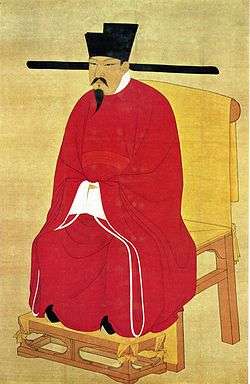Emperor Shenzong of Song
| Emperor Shenzong of Song 宋神宗 | |||||||||||||
|---|---|---|---|---|---|---|---|---|---|---|---|---|---|
|
| |||||||||||||
| Emperor of the Song dynasty | |||||||||||||
| Reign | 25 January 1067 – 1 April 1085 | ||||||||||||
| Predecessor | Emperor Yingzong | ||||||||||||
| Successor | Emperor Zhezong | ||||||||||||
| Born |
Zhao Zhongzhen (1048–1067) Zhao Xu (1067–1085) 25 May 1048 | ||||||||||||
| Died | 1 April 1085 (aged 36) | ||||||||||||
| Empresses |
Empress Qinsheng Empress Qincheng Empress Qinci | ||||||||||||
| Concubines |
| ||||||||||||
| Issue | |||||||||||||
| |||||||||||||
| House | House of Zhao | ||||||||||||
| Father | Emperor Yingzong | ||||||||||||
| Mother | Empress Gao | ||||||||||||
| Emperor Shenzong of Song | |||||||
| Chinese | 宋神宗 | ||||||
|---|---|---|---|---|---|---|---|
| Literal meaning | "Spirit Ancestor of the Song" | ||||||
| |||||||
| Zhao Xu | |||||||
| Traditional Chinese | 趙頊 | ||||||
| Simplified Chinese | 赵顼 | ||||||
| |||||||
| Zhao Zhongzhen | |||||||
| Traditional Chinese | 趙仲鍼 | ||||||
| Simplified Chinese | 赵仲针 | ||||||
| |||||||
Emperor Shenzong of Song (25 May 1048 – 1 April 1085), personal name Zhao Xu, was the sixth emperor of the Song dynasty in China. His original personal name was Zhao Zhongzhen but he changed it to "Zhao Xu" after his coronation. He reigned from 1067 until his death in 1085.
Life and reign
During his reign, Emperor Shenzong became interested in Wang Anshi's policies and appointed Wang as the Chancellor. Wang implemented his famous New Policies aimed at improving the situation for the peasantry and unemployed, which some have seen as a forerunner of the modern welfare state. These acts became the hallmark reform of Emperor Shenzong's reign.
Emperor Shenzong sent failed campaigns against the Vietnamese ruler Lý Nhân Tông of the Lý dynasty in 1076.[1]
Emperor Shenzong's other notable act as emperor was his attempt to weaken the Tangut-led Western Xia state by invading and expelling the Western Xia forces from Gansu Province. The Song army was initially quite successful at these campaigns, but during the battle for the city of Yongle, in 1082, Song forces were defeated. As a result, Western Xia grew more powerful and subsequently continued to be a thorn in the side of the Song Empire over the ensuing decades.
During Emperor Shenzong's reign, Sima Guang, a minister interested in the history of the previous 1000 years, wrote a very influential history book, the Zizhi Tongjian or A Comprehensive Mirror for Aid in Government. This book records historical events from the Zhou dynasty to the Song dynasty. Another notable literary achievement which occurred during his reign was the compilation of the Seven Military Classics, including the alleged forgery of the Questions and Replies between Tang Taizong and Li Weigong.[2]
Aside from the ancient Roman embassies to Han and Three-Kingdoms era China, contact with Europe remained sparse if not nonexistent before the 13th century. However, from Chinese records it is known that Michael VII Doukas (Mie li sha ling kai sa 滅力沙靈改撒) of Fo lin (i.e. the Byzantine Empire) dispatched a diplomatic mission to China's Song dynasty that arrived in 1081, during the reign of Emperor Shenzong.[3]
Emperor Shenzong died in 1085 at the age of 36 and was succeeded by his son, Emperor Zhezong.
Family
Emperor Shenzong's younger sister (Princess Shuguo, 1051-1080) was married to Wang Shen.[4]
See also
References
- ↑ Maspéro, Georges (2002). The Champa Kingdom: The History of an Extinct Vietnamese Culture. White Lotus Press. p. 71. ISBN 978-974-7534-99-3.
- ↑ Sawyer, Ralph D. (1993). The Seven Military Classics of Ancient China. Westview Press. p. 489. ISBN 978-0-8133-1228-6.
- ↑ Sezgin, Fuat; Ehrig-Eggert, Carl; Mazen, Amawi; Neubauer, E. (1996). نصوص ودراسات من مصادر صينية حول البلدان الاسلامية. Frankfurt am Main, Germany: Institute for the History of Arabic-Islamic Science at the Johann Wolfgang Goethe University. p. 25.
- ↑ Murck, Alfreda (2000). Poetry and Painting in Song China: The Subtle Art of Dissent. Harvard Univ Asia Center. p. 126. ISBN 978-0-674-00782-6.
| Emperor Shenzong of Song Born: 25 May 1048 Died: 1 April 1085 | ||
| Regnal titles | ||
|---|---|---|
| Preceded by Emperor Yingzong |
Emperor of the Song Dynasty 1067–1085 |
Succeeded by Emperor Zhezong |
